Mars 2018

UTC
My first image of Mars this apparition. This is the first time I'm using an Orion Luminance filter for UV/IR cut. I was hoping to use it to improve color balance using the south polar cap as a reference for white, but the dust storm obscured it to the point of being useless.
Notes:
- Dust is covering much of the visible northern hemisphere of the planet, but the summit of Elysium Mons appears as a dot near the limb.
- Mare Cimmerium and the surrounding regions are visible, most of it past the CM.

UTC
Seeing became good after we moved on from Saturn to Mars. However, clouds were passing through the area, leaving me to make quick captures when an opening passed in front of Mars. I believe a good color balance for the ASI224MC has been found after two years of working on it. It leaves the surface color a little paler than I like, but features that are white are now appear white in photos taken with this camera.
Notes:
- The north polar hood is peeking over the northern limb, presumably above the dust.
- The global dust storm has left a very opaque view of most of the surface.
- Hellas Basin appears to be covered by a completely opaque cloud of dust, which also appears to be extending east out of the basin.
- The south polar cap is covered in dust on the eastern side, but mostly clear on the western side.
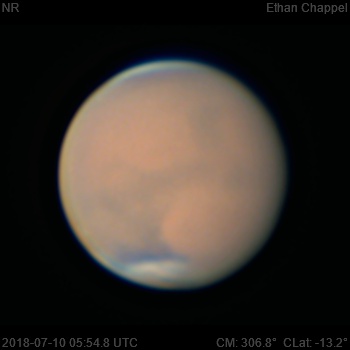
UTC
Seeing improved after the first Mars photo. I was continuing to capture between clouds.
Notes:
- The north polar hood is peeking over the northern limb, presumably above the dust.
- The global dust storm has left a very opaque view of most of the surface.
- Hellas Basin appears to be covered by a completely opaque cloud of dust, which also appears to be extending east out of the basin.
- The south polar cap is covered in dust on the eastern side, but mostly clear on the western side.
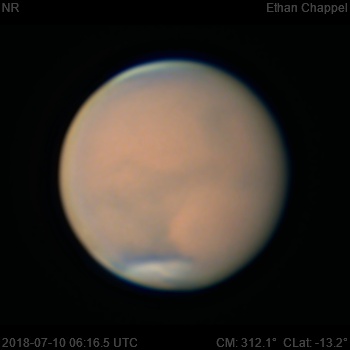
UTC
Seeing remained steady, but clouds remained a persistent issue.
Notes:
- The north polar hood is peeking over the northern limb, presumably above the dust.
- The global dust storm has left a very opaque view of most of the surface.
- Hellas Basin appears to be covered by a completely opaque cloud of dust, which also appears to be extending east out of the basin.
- The south polar cap is covered in dust on the eastern side, but mostly clear on the western side.
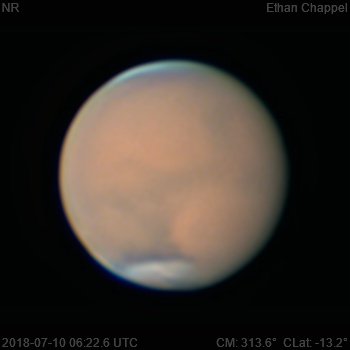
UTC
Clouds ended the imaging session after this photo.
Notes:
- The north polar hood is peeking over the northern limb, presumably above the dust.
- The global dust storm has left a very opaque view of most of the surface.
- Hellas Basin appears to be covered by a completely opaque cloud of dust, which also appears to be extending east out of the basin.
- The south polar cap is covered in dust on the eastern side, but mostly clear on the western side.

UTC
Seeing started out great for Mars. Clouds weren't present unlike the previous night.
Notes:
- The entire atmosphere of the planet is nearly opaque from the dust storm.
- Hellas Basin is just passed the CM and appears to be filled with dust.
- The part of the SPC east of the CM appears to be covered by a thicker layer of dust than the area west of it.

UTC
The sky continued to be steady and free of clouds.
Notes:
- The entire atmosphere of the planet is nearly opaque from the dust storm.
- Hellas Basin appears to be filled with dust.
- The eastern part of the SPC appears to be covered by a thicker layer of dust than the western part of it.
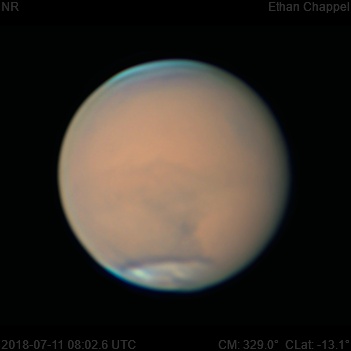
UTC
Sky conditions continued to be excellent.
Notes:
- The entire atmosphere of the planet is nearly opaque from the dust storm.
- Syrtis Major is setting
- Sinus Sabeaus is at the CM.
- Hellas Basin appears to be filled with dust.
- The SPC is very wide.

UTC
Final photo for the night. Seeing remained excellent.
Notes:
- The entire atmosphere of the planet is nearly opaque from the dust storm.
- Sinus Sabeaus is just past the CM.
- Hellas Basin is setting and appears to be filled with dust.
- The SPC is very wide.

UTC
The night started out with excellent seeing!
Notes:
- The entire planet is shrouded by the dust storm.
- Syrtis Major is past the central meridian.
- Hellas Basin and the surrounding area appear to be obscured by a completely opaque cloud of dust.
- Several marking are visible on the south polar cap.
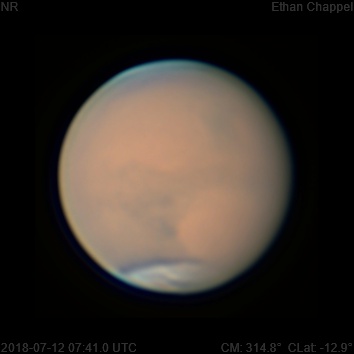
UTC
Conditions continued to be excellent.
Notes:
- The entire planet is shrouded by the dust storm.
- Syrtis Major is heading towards the terminator.
- Hellas Basin and the surrounding area appear to be obscured by a completely opaque cloud of dust.
- Several marking are visible on the south polar cap.

UTC
The final photo of the session had excellent conditions.
Notes:
- The entire planet is shrouded by the dust storm.
- Syrtis Major is near the terminator.
- Hellas Basin and the surrounding area appear to be obscured by a completely opaque cloud of dust.
- Several marking are visible on the south polar cap.

UTC
Seeing was very good. Just like Saturn, this was our first night imaging Mars with the C14 EdgeHD
Notes:
- The NPH is peeking over the limb.
- Sinus Meridiani is rising, with part of it being completely obscured by airborne dust.
- Syrtis Major is at the CM.
- An especially thick cloud of dust is obscuring Hellas Basin and the surrounding area.
- The SPC is partly obscured by airborne dust.

UTC
Seeing continued to be great.
Notes:
- The NPH is peeking over the limb.
- Sinus Meridiani is rising, with part of it being completely obscured by airborne dust.
- Syrtis Major is at the CM.
- An especially thick cloud of dust is obscuring Hellas Basin and the surrounding area.
- The SPC is partly obscured by airborne dust.
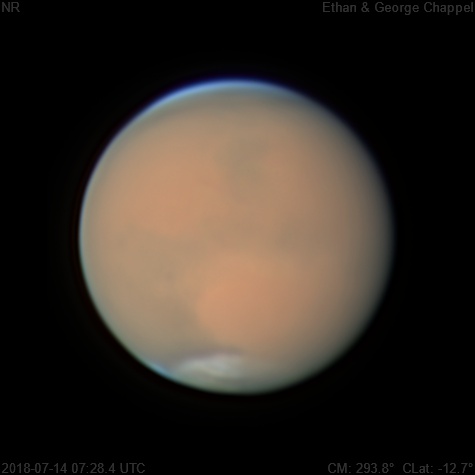
UTC
Seeing continued to be great.
Notes:
- The NPH is peeking over the limb.
- Sinus Meridiani is rising, with part of it being completely obscured by airborne dust.
- Syrtis Major is at the CM.
- An especially thick cloud of dust is obscuring Hellas Basin and the surrounding area.
- The SPC is partly obscured by airborne dust.
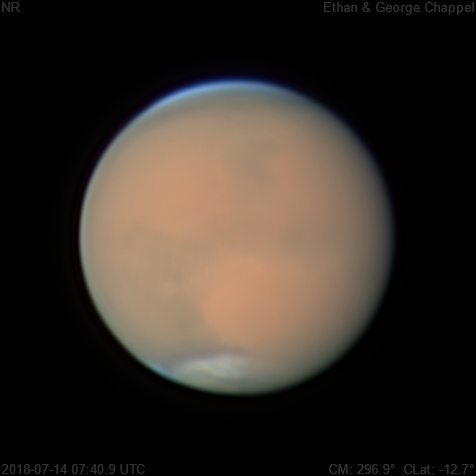
UTC
Seeing continued to be great.
Notes:
- The NPH is peeking over the limb.
- Part of Sinus Meridiani is completely obscured by airborne dust.
- Syrtis Major is past the CM.
- An especially thick cloud of dust is obscuring Hellas Basin and the surrounding area.
- The SPC is partly obscured by airborne dust.

UTC
Seeing continued to be great.
Notes:
- The NPH is peeking over the limb.
- Part of Sinus Meridiani is completely obscured by airborne dust.
- Syrtis Major is past the CM.
- An especially thick cloud of dust is obscuring Hellas Basin and the surrounding area.
- The SPC is partly obscured by airborne dust.
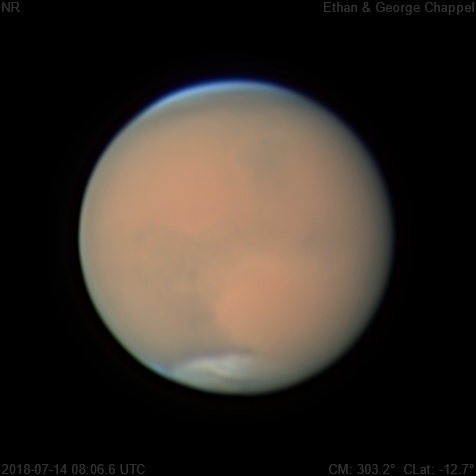
UTC
The last RGB photo of Mars for the night. Seeing continued to be great.
Notes:
- The NPH is peeking over the limb.
- Part of Sinus Meridiani is completely obscured by airborne dust.
- Syrtis Major is past the CM.
- An especially thick cloud of dust is obscuring Hellas Basin and the surrounding area.
- The SPC is partly obscured by airborne dust.
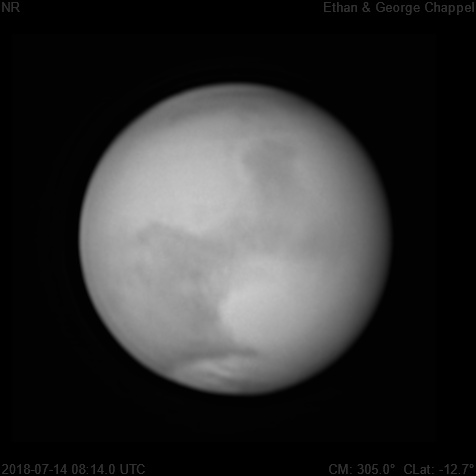
UTC
Before clouds took over the sky, I felt the need to capture an IR photo. Seeing remained great, but clouds decreased transparency.
Notes:
- Part of Sinus Meridiani is completely obscured by airborne dust.
- Syrtis Major is past the CM.
- The opaque (in visible light) cloud over Hellas Basin and the surrounding area is more transparent in IR.

UTC
Seeing was not bad, but not as good as July 14th, and transparency was extremely variable due to clouds coming through. While processing the Mars images from this night, our hard drive started slowing down and eventually started giving I/O errors, usually a sign that a drive has failed. Fortunately, restarting my computer fixed all the problems but I decided to back up the remaining 1 terabyte of unprocessed data to another drive to be safe.
Notes:
- Syrtis Major is rising.
- Dust clouds appear to be escaping from Hellas Basin.
- The south polar cap is mostly obscured by dust.
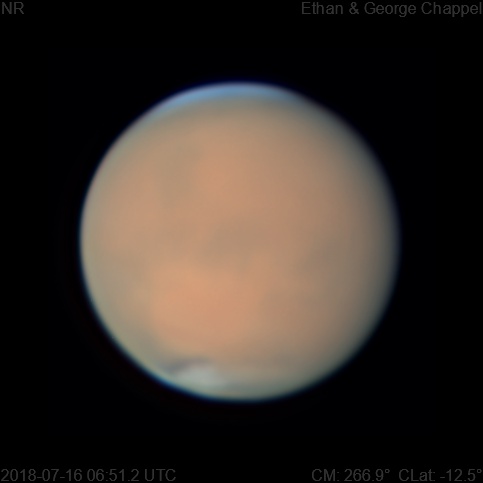
UTC
Seeing improved slightly and transparency remained volatile.
Notes:
- Syrtis Major is rising.
- Dust clouds appear to be escaping from Hellas Basin.
- The south polar cap is mostly obscured by dust.

UTC
Seeing continued top be slightly improved transparency became good when the sky cleared up.
Notes:
- Syrtis Major is approaching the central meridian.
- Dust clouds appear to be escaping from Hellas Basin.
- The south polar cap is mostly obscured by dust.
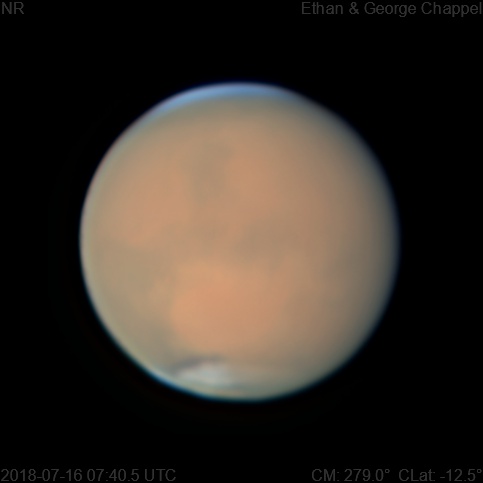
UTC
Seeing improved again, but clouds returned and ended the session after this photo.
Notes:
- Syrtis Major is approaching the central meridian.
- Sinus Meridiani is rising.
- Dust clouds appear to be escaping from Hellas Basin.
- Half of the south polar cap is obscured by dust.

UTC
Seeing started out decent for Mars. Saharan dust limited transparency, but not as much as the previous night.
Notes:
- Syrtis Major is rising.
- There's a faint cloud above the dust storm in much of the southern hemisphere east of the central meridian.
- Mare Tyrrhenum is hidden under a completely opaque part of the dust storm
- Mare Cimmerium is relatively visible.
- The brightness of the south polar cap is muted by the dust storm. The cap also appears to have a hole.
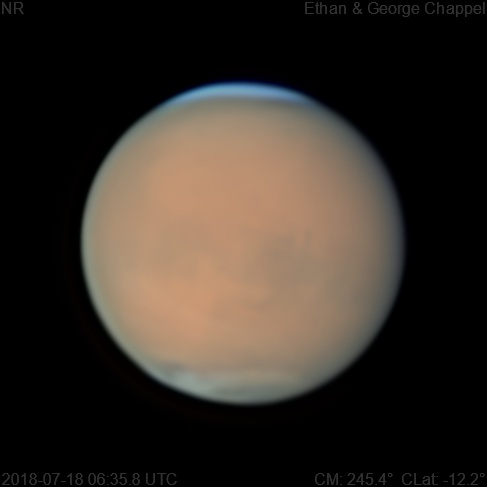
UTC
Seeing continued to be decent. Saharan dust limited transparency, but not as much as the previous night.
Notes:
- Syrtis Major is rising.
- There's a faint cloud above the dust storm in much of the southern hemisphere east of the central meridian.
- Mare Tyrrhenum is hidden under a completely opaque part of the dust storm
- Mare Cimmerium is relatively visible.
- The brightness of the south polar cap is muted by the dust storm. The cap also appears to have a hole.

UTC
Seeing continued to be decent. Saharan dust limited transparency, but not as much as the previous night.
Notes:
- Syrtis Major is rising.
- There's a faint cloud above the dust storm in much of the southern hemisphere east of the central meridian.
- Mare Tyrrhenum is hidden under a completely opaque part of the dust storm
- Mare Cimmerium is relatively visible.
- The brightness of the south polar cap is muted by the dust storm. The cap also appears to have a hole.

UTC
I decided to capture an IR photo part-way through our time with Mars. Seeing did not improve, but the IR filter cut through some of it.
Notes:
- Syrtis Major is rising.
- Mare Tyrrhenum is visible despite being hidden in RGB.
- Mare Cimmerium is under a thinner veil of dust, making it more visible.
- The south polar cap appears to have a hole.
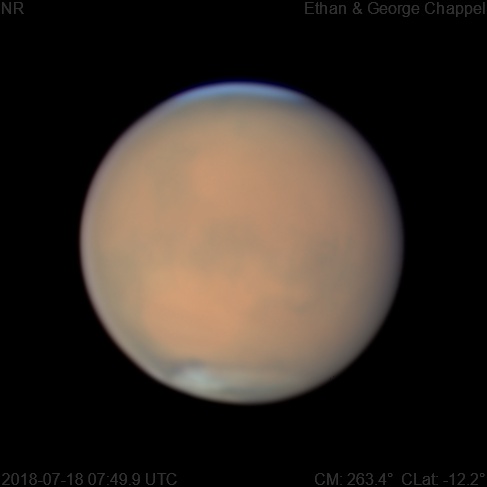
UTC
Seeing continued to be decent. Saharan dust limited transparency, but not as much as the previous night.
Notes:
- There's a faint cloud above the dust storm in much of the southern hemisphere east of the central meridian.
- Mare Tyrrhenum is hidden under a completely opaque part of the dust storm.
- Mare Cimmerium is relatively visible compared to other dark features.
- The brightness of the south polar cap is muted by the dust storm. The cap also appears to have a hole.
- Hellas Basin is under a bright cloud of dust.

UTC
Seeing remained decent. After this photo, clouds from the south took over the sky and ended the night of imaging.
Notes:
- There's a faint cloud above the dust storm in much of the southern hemisphere east of the central meridian. At this point, it has become fainter than earlier in the night.
- Mare Cimmerium is setting.
- Most of the south polar cap is covered by dust. The cap also appears to have a hole.
- Hellas Basin is under a bright cloud of dust.
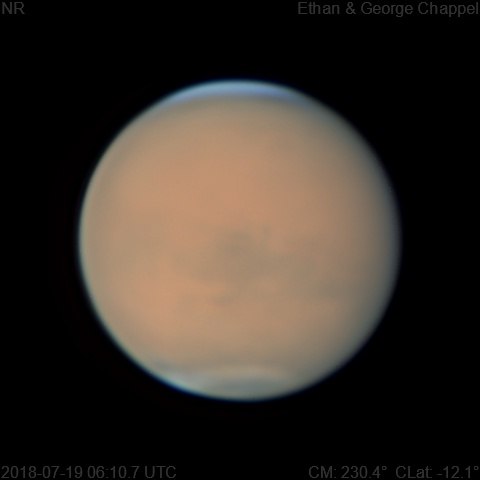
UTC
Seeing started out good as we turned our attention from Saturn to Mars.
Notes:
- Syrtis Major and Hellas Basin are rising.
- Mare Cimmerium appears to be covered by less dust than surrounding areas.
- The South Polar Cap appears muted by the dust storm.
- Most of the SPC also appears to be darkened.
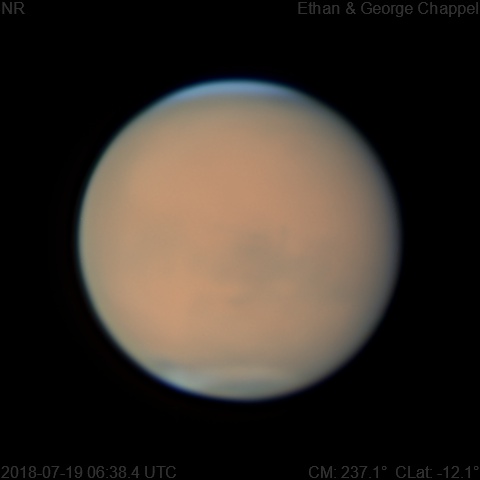
UTC
Seeing worsened slightly but continued to be generally good.
Notes:
- Syrtis Major and Hellas Basin are rising.
- Mare Cimmerium appears to be covered by less dust than surrounding areas.
- The South Polar Cap appears muted by the dust storm.
- Most of the SPC also appears to be darkened.
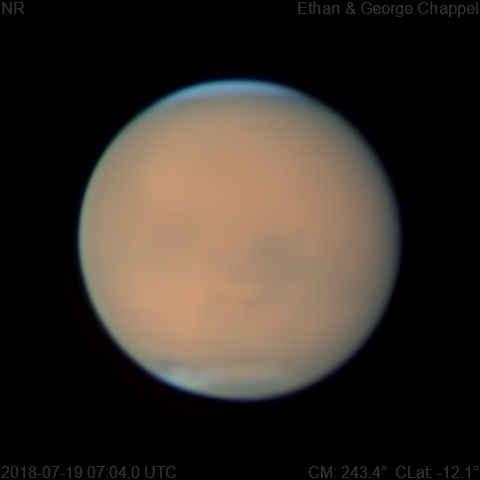
UTC
Seeing improved back to how it was during the first image of Mars for the night.
Notes:
- Syrtis Major and Hellas Basin are rising.
- Mare Cimmerium appears to be covered by less dust than surrounding areas.
- The South Polar Cap appears muted by the dust storm.
- Most of the SPC also appears to be darkened.
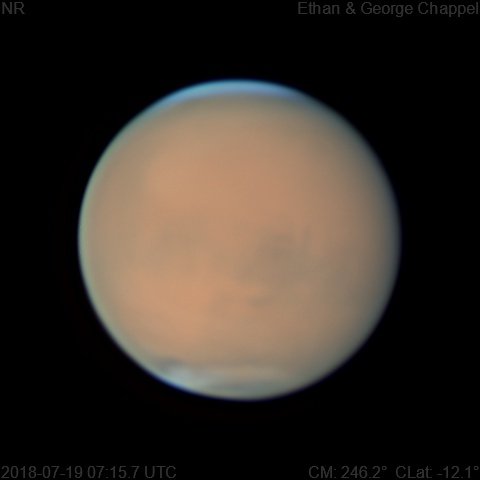
UTC
Seeing remained good for our last RGB photo of Mars for the night.
Notes:
- Syrtis Major and Hellas Basin are rising.
- Mare Cimmerium appears to be covered by less dust than surrounding areas.
- The South Polar Cap appears muted by the dust storm.
- Most of the SPC also appears to be darkened.
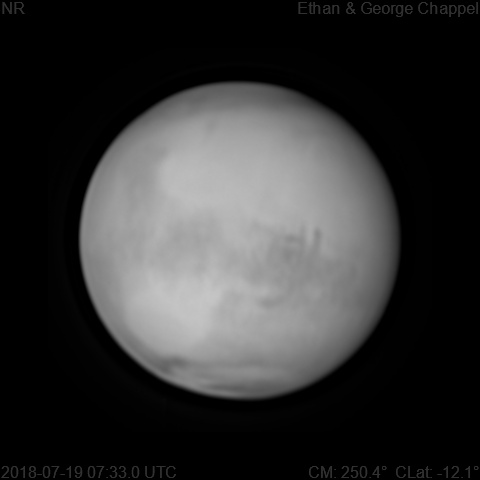
UTC
I decided to capture data in infrared before closing down for the night. Seeing continued to be good.
Notes:
- Syrtis Major and Hellas Basin are rising.
- Mare Cimmerium is the dark feature most prominently visible through the dust storm.
- The South Polar Cap appears muted by the dust storm.
- Most of the SPC also appears to be darkened.
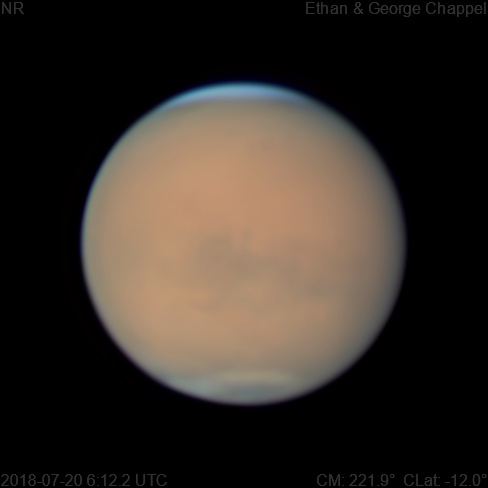
UTC
Seeing was great as we moved on to Mars from Saturn.
Notes:
- The atmosphere above Mare Cimmerium appears to be less opaque than surrounding areas.
- The South Polar Cap appears muted by the dust storm.
- Most of the SPC also appears to be darkened.
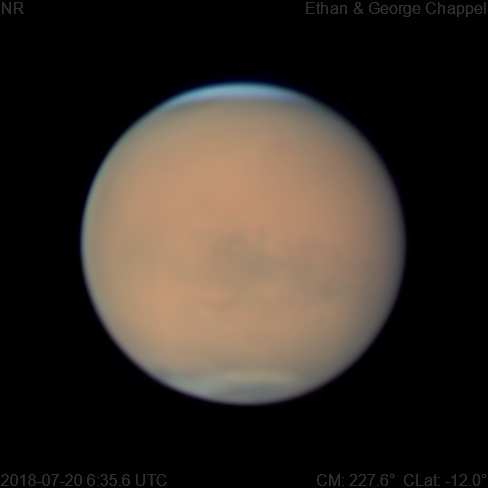
UTC
Seeing was great as we continued capturing Mars.
Notes:
- Syrtis Major is rising.
- The atmosphere above Mare Cimmerium appears to be less opaque than surrounding areas.
- The South Polar Cap appears muted by the dust storm.
- Most of the SPC also appears to be darkened.

UTC
Seeing was great as we moved on to Mars from Saturn.
Notes:
- Syrtis Major is rising.
- The atmosphere above Mare Cimmerium appears to be less opaque than surrounding areas.
- The South Polar Cap still appears to be muted by the dust storm.
- Most of the SPC also appears to be darkened.
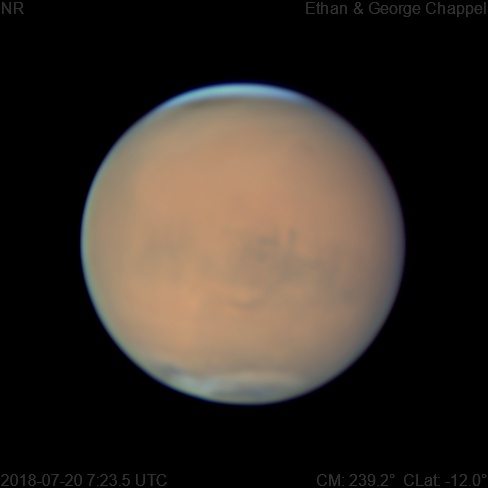
UTC
Seeing further improved, perhaps becoming the best it has been while imaging Mars with the C14.
Notes:
- Syrtis Major is rising.
- The atmosphere above Mare Cimmerium appears to be less opaque than surrounding areas.
- Hellas Basin has a few yellow clouds streaking over it.
- The South Polar Cap still appears to be muted by the dust storm.
- Most of the SPC also appears to be darkened.

UTC
Seeing remained excellent. After this photo, I took some time to view Mars through a Celestron Luminos 23mm eyepiece, which I affectionately call the "Beer Can Eyepiece". The difference in color between the South Polar Cap was surprisingly striking to the eye. Dark albedo markings were barely visible.
Notes:
- Syrtis Major is rising.
- The atmosphere above Mare Cimmerium appears to be less opaque than surrounding areas.
- Hellas Basin has a few yellow clouds streaking over it.
- The South Polar Cap still appears to be muted by the dust storm.
- Most of the SPC also appears to be darkened.
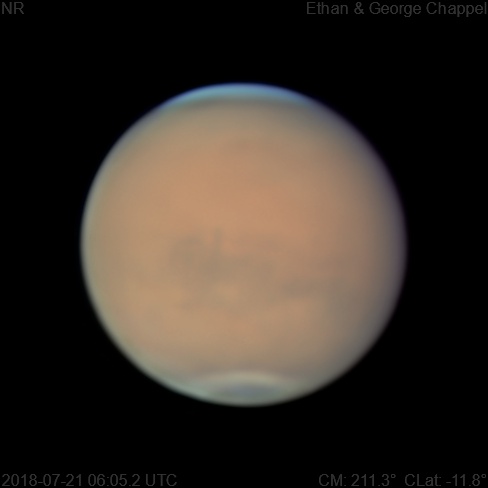
UTC
Seeing was decent, but not as good as the previous night.
Notes:
- Mare Cimmerium is visible despite the global dust storm.
- The South Polar Cap is covered by the dust storm.
- The SPC on visible hemisphere has a dark center with a brighter perimeter.
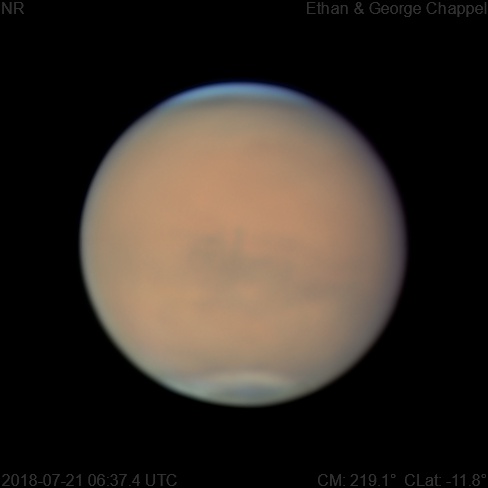
UTC
Conditions were still only average.
Notes:
- Hellas Basin is rising.
- Mare Cimmerium is visible despite the global dust storm.
- The South Polar Cap is covered by the dust storm.
- The SPC on visible hemisphere has a dark center with a brighter perimeter.
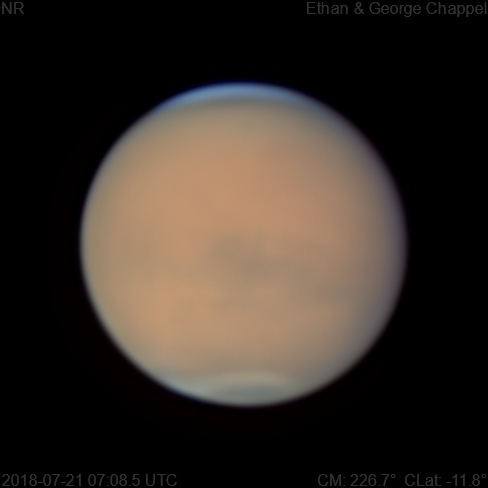
UTC
Seeing deteriorated a little bit compared to the previous image.
Notes:
- Syrtis Major is rising.
- Hellas Basin is rising.
- Mare Cimmerium is visible despite the global dust storm.
- The South Polar Cap is covered by the dust storm.
- The SPC on visible hemisphere has a dark center with a brighter perimeter.

UTC
Seeing conditions started recovering after slowly deteriorating while capturing previous images.
Notes:
- Syrtis Major is rising.
- Hellas Basin is rising.
- Mare Cimmerium is visible despite the global dust storm.
- The South Polar Cap is covered by the dust storm.
- The SPC on visible hemisphere has a dark center with a brighter perimeter.
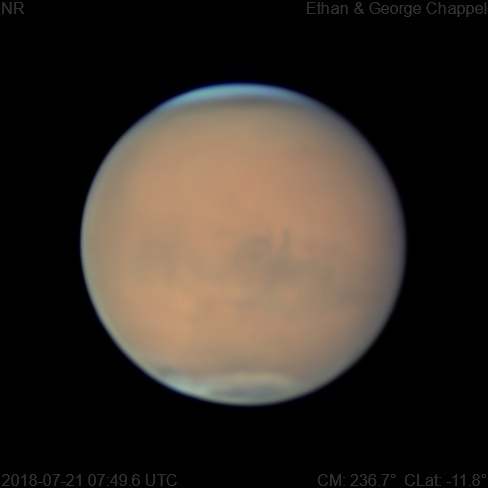
UTC
Seeing became great while capturing this final visible light photo of Mars for the night.
Notes:
- Syrtis Major is rising.
- Hellas Basin is rising.
- Mare Cimmerium is visible despite the global dust storm.
- The South Polar Cap is covered by the dust storm.
- The SPC on visible hemisphere has a dark center with a brighter perimeter.
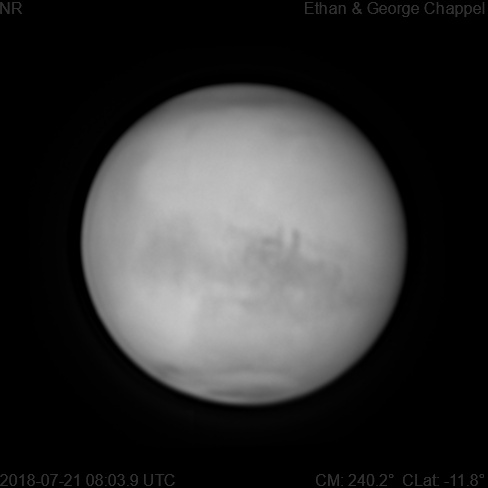
UTC
Before packing up for the night, I decided to capture an infrared photo of Mars. Seeing was great.
Notes:
- Syrtis Major is rising.
- Hellas Basin is rising.
- Mare Cimmerium is past the central meridian.
- The South Polar Cap on visible hemisphere has a dark center with a brighter perimeter.
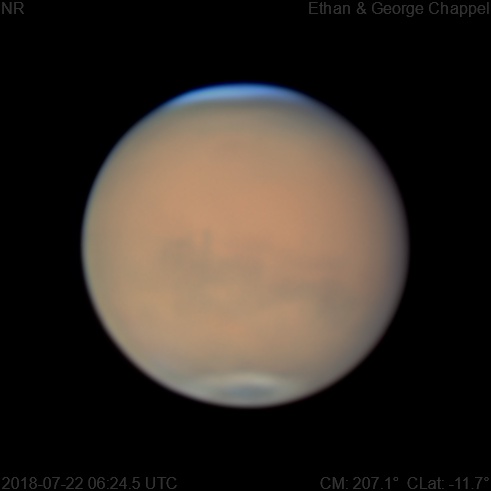
UTC
Seeing remained above average after moving on from Saturn and transparency was excellent as it was the previous few nights.
Notes:
- Mare Cimmerium is sprawling across the disk.
- The South Polar Cap has a dark core.

UTC
Seeing remained above average.
Notes:
- Mare Cimmerium is sprawling across the disk.
- The South Polar Cap has a dark core.
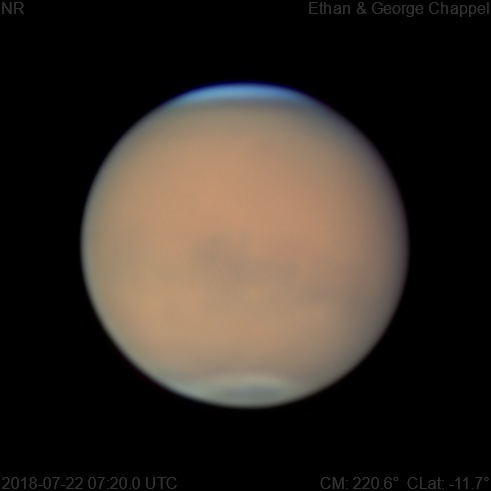
UTC
The night ended with above average seeing, though a little worse than earlier photos.
Notes:
- Mare Cimmerium is sprawling across the disk.
- Hellas Basin is rising.
- The South Polar Cap has a dark core.
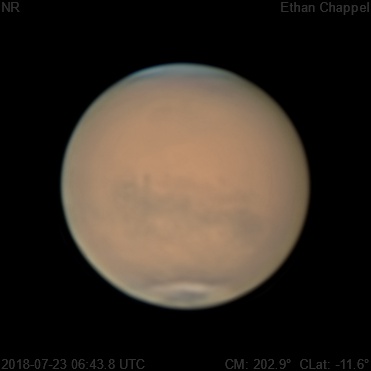
UTC
Seeing and transparency was excellent. The ASI224MC doesn't seem to pick up blue as well as the ASI290MM and filters.
Notes:
- Mare Cimmerium is visible under the global dust storm.
- The South Polar Cap is covered by the dust storm.
- The SPC on visible hemisphere has a dark center with a brighter perimeter.

UTC
Seeing and transparency continued to be excellent for my last Mars photo of the night.
Notes:
- Mare Cimmerium is visible under the global dust storm.
- The South Polar Cap is covered by the dust storm.
- The SPC on visible hemisphere has a dark center with a brighter perimeter.
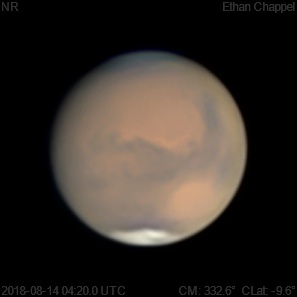
UTC
Seeing was much better than it was for Jupiter & Saturn.
Notes:
- Syrtis Major & Hellas Basin are about to set.
- Sinus Meridiani is near the central meridian.
- The South Polar Cap has shrunken a noticeable amount since July 12th.
- The edge of the SPC also looks rougher than it did in July.

UTC
Seeing was very good.
Notes:
- Sinus Meridiani is near the central meridian.
- Syrtis Major & Hellas Basin are setting.
- The South Polar Cap has rough edges.

UTC
Seeing remained good as it did earlier in the session for Saturn.
Notes:
- Sinus Meridiani is rising.
- Syrtis Major and Hellas Basin are setting.
- The South Polar Cap's shape is asymmetric.

UTC
Seeing was still good for the last image of the night.
Notes:
- Sinus Meridiani is approaching the central meridian.
- Syrtis Major and Hellas Basin are setting.
- The South Polar Cap's shape is asymmetric.

UTC
As with the previous few nights, the seeing for Mars was very good.
Notes:
- Sinus Meridiani is rising and almost reaches the central meridian.
- Syrtis Major and Hellas Basin are just past the central meridian.
- The South Polar Cap appears to have uneven edges.
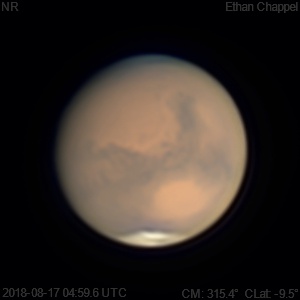
UTC
Conditions remained excellent as I wrapped up the night with this Mars photo.
Notes:
- Sinus Meridiani is rising and reaches the central meridian.
- Syrtis Major and Hellas Basin are just past the central meridian.
- The South Polar Cap appears to have uneven edges.

UTC
Seeing was very good.
Notes:
- The atmosphere appears less opaque compared to just over a month before.
- Sinus Meridiani is rising.
- Syrtis Major and Hellas Basin are at the central meridian.
- Mare Cimmerium is setting.
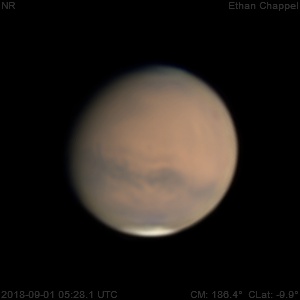
UTC
As I moved on to Mars, sky conditions continued to be great.
Notes:
- Olympus Mons is setting.
- The western edge of Cimmerium is rising.
- Mare Sirenium is setting.
- The south polar cap appears to have a fuzzy edge.
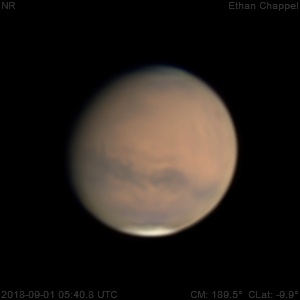
UTC
Sky conditions continued were very good as I wrapped up imaging for the night.
Notes:
- Olympus Mons is setting.
- The western edge of Cimmerium is rising.
- Mare Sirenium is setting.
- The south polar cap appears to have a fuzzy edge.
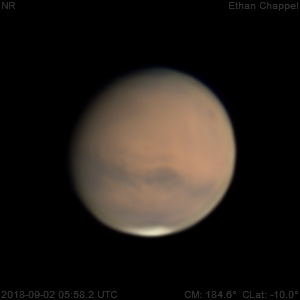
UTC
Conditions were just as good as last night for Mars.
Notes:
- Olympus Mons is setting.
- The western edge of Cimmerium is rising.
- Mare Sirenium is setting.
- The south polar cap appears to have a fuzzy edge.

UTC
Seeing remained excellent as I wrapped up the imaging session.
Notes:
- Olympus Mons is setting.
- The western edge of Cimmerium is rising.
- Mare Sirenium is setting.
- The south polar cap appears to have a fuzzy edge.

UTC
Seeing was much better than it was for Saturn.
Notes:
- Olympus Mons is setting
- Mare Cimmerium is sprawled across the southern hemisphere.
- There appears to be some clouds near the south pole.
- The south polar cap continues to shrink as spring progresses.

UTC
Seeing started out very good. This is our first time using the C14 on Mars without a global dust storm!
Notes:
- Sinus Meridiani is emerging from the night side.
- Syrtis Major and Hellas Basin are about to set.
- Little is left of the south polar cap.
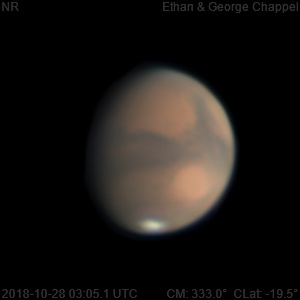
UTC
Sky conditions remained great, but heat plumes from a nearby roof started to have an effect as Mars approached it.
Notes:
- Sinus Meridiani is emerging from the night side.
- Syrtis Major and Hellas Basin are about to set.
- Very little is left of the South polar cap.

UTC
Heat plumes from a nearby roof continue to take their toll on the stability of air.
Notes:
- Sinus Meridiani is emerging from the night side.
- Syrtis Major and Hellas Basin are about to set.
- Very little is left of the South polar cap.
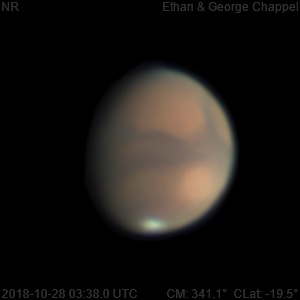
UTC
Seeing continued to worsen as Mars approached a roof giving off heat plumes.
Notes:
- Sinus Meridiani is emerging from the night side.
- Syrtis Major and Hellas Basin are setting.
- Hellas Basin appears to be covered in bright dust.
- Very little is left of the South polar cap.
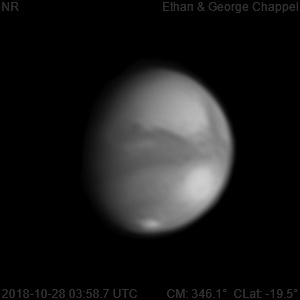
UTC
Before finishing up on Mars, I wanted to get an infrared photo of Mars to cut through the heat plumes.
Notes:
- Sinus Meridiani is at the central meridian.
- Syrtis Major and Hellas Basin are setting.
- Hellas Basin appears to be covered in bright dust.
- Very little is left of the South polar cap.

UTC
With Saturn becoming too low to photograph, I turned my attention to Mars, where the seeing was much better due to the higher elevation.
Notes:
- Sinus Meridiani is emerging from the night side of Mars.
- Syrtis Major and Hellas Basin are just past the central meridian.
- The south polar cap is small.
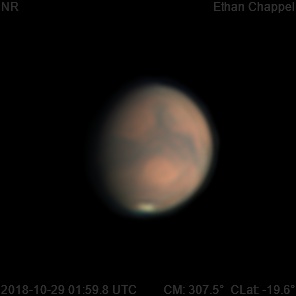
UTC
Sky conditions continued to be good. Unlike the C14, the sky is open along the entire ecliptic where the C8 is located.
Notes:
- Sinus Meridiani is emerging from the night side of Mars.
- Syrtis Major and Hellas Basin are just past the central meridian.
- The south polar cap is small.
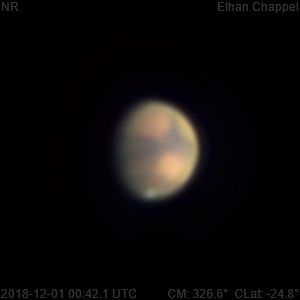
UTC
Imaging Mars is becoming more difficult as it recedes from Earth. Poor seeing didn't help either.
Notes:
- Sinus Meridiani is emerging from the night side.
- Syrtis Major and Hellas Basin are about to set.
- The south polar cap is about as small as it can get.
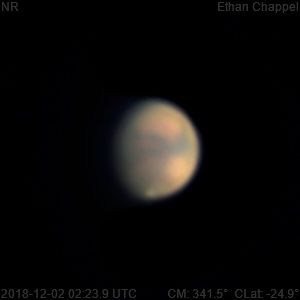
UTC
Seeing was even worse than the previous night.
Notes:
- Sinus Meridiani is at the central meridian.
- Syrtis Major and Hellas Basin are setting.
- The south polar cap is about as small as it can get.
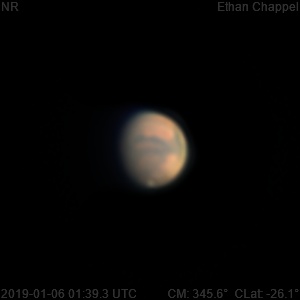
UTC
Mars is only 7.1" in width, or about 30% of its apparent width at the end of July. Sky conditions were much better tonight compared to last month.
Notes:
- Sinus Meridiani is at the central meridian.
- Syrtis Major and Hellas Basin are setting.
- The bright orange cloud over Hellas looks like it may have escaped the basin on its western side.
- The south polar cap is very small.
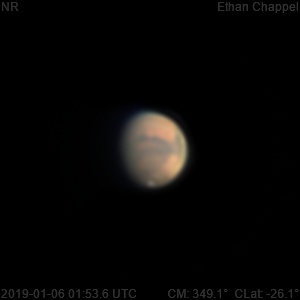
UTC
The sky continues to be cooperative.
Notes:
- Sinus Meridiani is at the central meridian.
- Syrtis Major and Hellas Basin are setting.
- The bright orange cloud over Hellas looks like it may have escaped the basin on its western side.
- The south polar cap is very small.

UTC
I decided to call it a night after this image so I could get enough sleep for Jupiter in the morning.
Notes:
- Sinus Meridiani is at the central meridian.
- Syrtis Major and Hellas Basin are setting.
- The bright orange cloud over Hellas looks like it may have escaped the basin on its western side.
- The south polar cap is very small.

UTC
A few months have passed since my last image of Mars.
Notes:
- The north polar cap is back in sunlight.
- Sinus Meridiani is at the central meridian.
- Hellas Basin is setting.